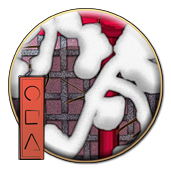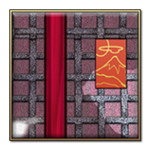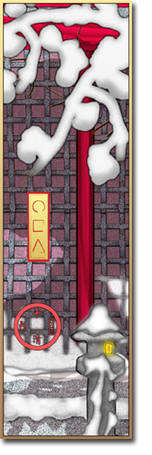On The Way: The Daily Zen Journal
Zen and the Art of Tea
D.T. Suzuki (1870-1966)
1.

What is common to Zen and the art of tea is the constant attempt both make at simplification. The elimination of the unnecessary is achieved by Zen in its intuitive grasp of final reality; by the art of tea, in the way of living typified by serving tea in the tearoom. The art of tea is the aestheticism of primitive simplicity.

Its ideal, to come closer to Nature, is realized by sheltering oneself under a thatched roof in a room which is hardly ten feet square but must be artistically constructed and furnished. Zen also aims at stripping off all the artificial wrappings humanity has devised, supposedly for its own solemnization.
Zen first of all combats the intellect; for, in spite of its practical usefulness, the intellect goes against our effort to delve into the depths of being. Philosophy may propose all kinds of questions for intellectual solution, but it never claims to give us the spiritual satisfaction which must be accessible to every one of us, however intellectually underdeveloped one may be.

Philosophy is accessible only to those who are intellectually equipped, and thus it cannot be a discipline of universal appreciation. Zen—or, more broadly speaking, religion– is to cast off all one thinks he possesses, even life, and to get back to the ultimate state of being, the “Original Abode,” one’s own father or mother.
This can be done by every one of us, for we are what we are because of it or him or her, and without it, or him, or her we are nothing. This is to be called the last stage of simplification, since things cannot be reduced to any simpler terms.
The art of tea symbolizes simplification, first of all, by an inconspicuous, solitary, thatched hut erected, perhaps under an old pine tree, as if the hut were part of nature and not specially constructed by human hands. When form is thus once and for all symbolized it allows itself to be artistically treated. It goes without saying that the principle of treatment is to be in perfect conformity with the original idea which prompted it, that is, the elimination of unnecessaries.

I have often thought of the art of tea in connection with Buddhist life, which seems to partake so much of the characteristics of the art. Tea keeps the mind fresh and vigilant, but it does not intoxicate. It has qualities naturally to be appreciated by scholars and monks. It is in the nature of things that tea came to be extensively used in the Buddhist monasteries, and that its first introduction to Japan came through the monks.
We can see now that the art of tea is most intimately connected with Zen not only in its practical development but principally in the observance of the spirit that runs through the ceremony itself. The spirit in terms of feeling consists of “harmony (wa), “reverence” (kei), “purity” (sei, and “tranquility” (jaku). These four elements are needed to bring the art to a successful end; they are all the essential constituents of a brotherly and orderly life, which is no other than the life of the Zen monastery.
2.
The character for “harmony” also reads “gentleness of spirit” (yawaragi), and to my mind “gentleness of spirit” seems to describe better the spirit governing the whole procedure of the art of tea. Harmony refers more to form, while gentleness is suggestive of an inward feeling.
The general atmosphere of the tearoom tends to create this kind of gentleness all around—gentleness of touch, gentleness of odor, gentleness of light, and gentleness of sound. You take up a teacup, handmade and irregularly shaped,in a glaze probably not uniformly overlaid, but in spite of this primitiveness the little utensil has a peculiar charm of gentleness, quietness, and unobtrusiveness.
The incense burning is never strong and stimulating, but gentle and pervading. The windows and screens are another source of a gentle pervading charm, for the light admitted into the room is always soft and restful and conducive to a meditative mood. The breeze passing through the needles of an old pine tree harmoniously blends with the sizzling of the iron kettle over the fire. The entire environment thus reflects the personality of the one who has created it.
When Dogen came back from China after some years of study of Zen there, he was asked what he had learned. He said, “Not much except soft-heartedness.” “Soft-heartedness” is “tender-mindedness” and in this case means “gentleness of spirit.” Generally we are too egoistic, too full of hard, resisting spirit. We are individualistic, unable to accept things as they are or as they come to us.
Resistance means friction, friction is the source of all trouble. When there is no self, the heart is soft and offers no resistance to outside influences. This does not necessarily mean the absence of all sensitivities or emotionalities. They are controlled in the totality of a spiritual outlook on life. Indeed, “gentleness of spirit” or “soft-heartedness” is the foundation of our life on earth. If the art of tea purports to establish a Buddha-land in its small group, it has to start with gentleness of spirit. To illustrate this point further, let us quote the Zen Master Takuan (1573-1645):

“The principle of cha-no-yu is the spirit of harmonious blending of Heaven and Earth and provides the means for establishing universal peace.
People of the present time have turned it into a mere occasion for meeting friends, talking of worldly affairs, and indulging in palatable food and drink; besides, they are proud of their elegantly furnished tearooms, where, surrounded by rare objects of art, they would serve tea in a most accomplished manner, and deride those who are not so skillful as themselves. This is, however, far from being the original intention of cha-no-yu.
Let us then construct a small room in a bamboo grove or under trees, arrange streams and rocks and plant trees and bushes, while inside the room let us pile up charcoal, set a kettle, arrange flowers, and arrange in order the necessary tea utensils.
And let all this be carried out in accordance with the idea that in this room we can enjoy the streams and rocks as we do the rivers and mountains in Nature, and appreciate the various moods and sentiments suggested by the snow, the moon, and the trees and flowers, as they go through the transformation of seasons, appearing and disappearing, blooming and withering.
As visitors are greeted here with due reverence, we listen quietly to the boiling water in the kettle, which sounds like a breeze passing through the pine needles, and become oblivious of all worldly woes and worries; we then pour out a dipperful of water from the kettle, reminding us of the mountain streams, and thereby our mental dust is wiped off. This is truly a world of recluses, saints on earth.
The principle of propriety is reverence, which in practical life functions as harmonious relationship”
Excerpted in part from Takuan on the Art of Tea (Cha-no-yu)
3.
One teamaster said: “The spirit of cha-no-yu is to cleanse the six senses of contamination. By seeing the kakemono (hanging scroll) in the tokonoma (alcove) and the flower in the vase, one’s sense of smell is cleansed; by listening to the boiling water in the iron kettle and to the dripping water from the bamboo pipe, one’s ears are cleansed; by tasting tea one’s mouth is cleansed; and by handling the tea utensils one’s sense of touch is cleansed. Thus all the sense organs are cleansed, and the mind itself is cleansed of defilements. The art of tea is after all a spiritual discipline, and my aspiration for every hour of the day is not to depart from the spirit of tea, which is by no means a matter of mere entertainment.”
The snow covered mountain path
Winding through the rocks
Has come to its end;
Here stands a hut,
The master is all alone;
No visitors he has,
Nor are any expected.
Sen no Rikyu (1521-1591)
D.T. Suzuki (1870-1966)
Excerpted from Zen and Japanese Culture – D. T. Suzuki 1959




How jarring it is to feel the silence and elegance of a Japanese tearoom in contradistinction to our current surroundings. The world has become very intrusive on so many levels, and sensory overload has become the norm. How do we hope to capture some of this quiet tranquility in our surroundings?
For many of us the pull to find a place of silence without is very compelling; at some point in practice after years of sitting the inner silence becomes the platform upon which the outer distractions reverberate, but no longer disturb.
How do we balance our numerous possessions with the stark simplicity of the tearoom? Our clutter of belongings and memories becomes another obstacle. Obviously, we are all works in progress. Any one of the elements of the tea ceremony, though, can become a touchstone for our lives: harmony, reverence, purity, and tranquility.
To commit to a standard we aspire to, not in the sense of rules that bind us, but aiming toward a mind that seeks the Way, defines a fully engaged life.
Aspiring together,
Elana, Scribe for Daily Zen